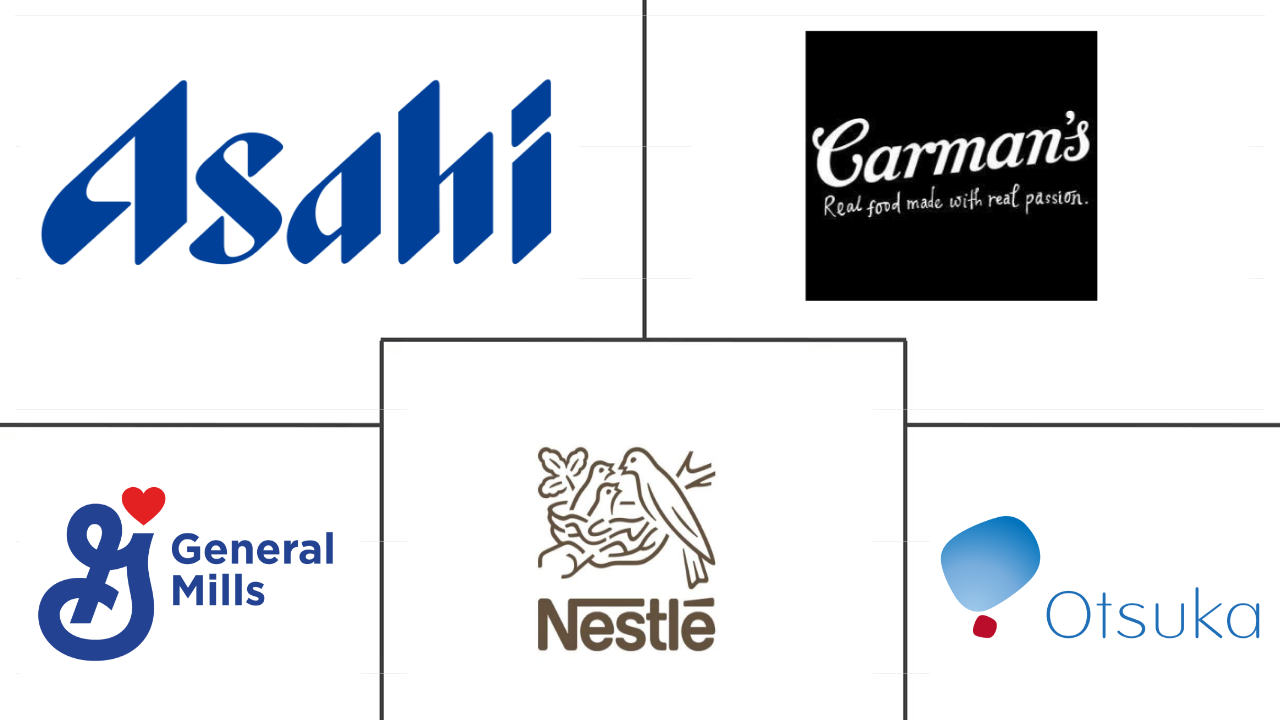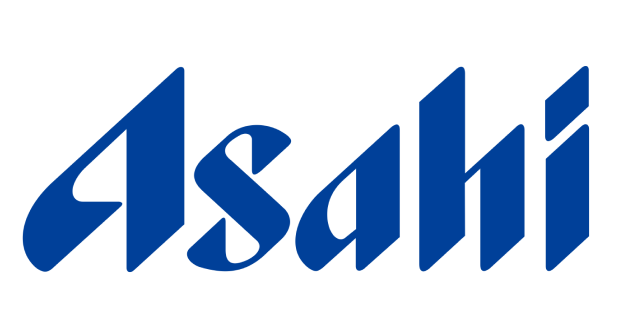Market Size of asia pacific snack bar Industry
|
|
Study Period | 2018 - 2030 |
|
|
Market Size (2024) | USD 1.97 Billion |
|
|
Market Size (2030) | USD 3.36 Billion |
|
|
Largest Share by Distribution Channel | Supermarket/Hypermarket |
|
|
CAGR (2024 - 2030) | 9.33 % |
|
|
Largest Share by Country | Japan |
Major Players |
||

|
||
|
*Disclaimer: Major Players sorted in no particular order |
APAC Snack Bars Market Analysis
The Asia Pacific Snack Bar Market size is estimated at 1.97 billion USD in 2024, and is expected to reach 3.36 billion USD by 2030, growing at a CAGR of 9.33% during the forecast period (2024-2030).
1.97 Billion
Market Size in 2024 (USD)
3.36 Billion
Market Size in 2030 (USD)
5.18 %
CAGR (2018-2023)
9.33 %
CAGR (2024-2030)
Largest Segment by Confectionery Variant
61.38 %
value share, Protein Bar, 2023
Recommendations by fitness clubs for protein bars acting as a substitute for regular meals are anticipated to drive the sales of these products during the forecast period.
Largest Segment by Distribution Channel
58.26 %
value share, Supermarket/Hypermarket, 2023
The product assortment and shelf space in supermarkets allow consumers to compare the products, which has emerged as one of the major factors driving segmental growth.
Fastest-growing Segment by Confectionery variant
11.67 %
Projected CAGR, Protein Bar, 2024-2030
Sedentary lifestyles & hectic work schedules are leading consumers to look for healthier alternatives present in the market, increasing demand for products like protein bars.
Fastest-growing Segment by Distribution Channel
12.02 %
Projected CAGR, Online Retail Store, 2024-2030
The ability to use online marketing tools to target new customers and website analysis tools to gain insight into regional product-specific consumers is driving the segment.
Leading Market Player
7.63 %
market share, Asahi Group Holdings Ltd, 2022

The company's main focus on product development made Asahi a market leader. It has been ramping up its existing range of products, highly influencing consumer behavior.
Supermarkets and hypermarkets account for a major market share as consumers are interested in in-person grocery shopping and discount offers
- In Asia-Pacific, the overall retailing segment maintained a growth rate of 4.59% in 2023 compared to 2022. The segment is anticipated to grow further with the consumers' growing inclination for convenient shopping facilities.
- Supermarkets and hypermarkets are the largest retailers in the Asia-Pacific snack bar market. These stores have a tendency to offer a wide range of chocolate products with creative offers to their customers. The sales volume of snack bar products in supermarkets and hypermarkets in the region grew by 4.22% in 2022, and it is anticipated to register a CAGR of 9.42% during 2025-2028. Through supermarkets and hypermarkets, cereal bars are sold the most, accounting for a 46.32% share of the total snack bar market in 2023, mainly due to the growing number of health-conscious consumers
- Under the overall retailing segment, convenience store was the second-largest segment by volume in 2023. Some of the popular stores in Asia-Pacific are Walmart, 7-Eleven, and Circle-K. By 2025, the convenience store segment in Asia-Pacific is estimated to register a growth rate of 4.48% by volume compared to 2020.
- Online retail store is the fastest-growing segment in Asia-Pacific. The e-commerce business accounted for a CAGR of 5.85% in 2023. The growing number of internet users across the region is the major factor influencing the acceleration of the growth of e-commerce websites.
- During the forecast period, the overall retailing segment in Asia-Pacific is expected to register a growth rate of 8.21% by volume. Factors such as rising interest in in-person shopping and discounts and offers are likely to drive the retailing industry drastically.
Growing awareness regarding health-oriented products is likely to boost the segment’s sales
- In Asia-Pacific, the snack bar segment witnessed a favorable value growth rate of 5.79% in 2023 compared to 2022, primarily due to the growing consciousness among consumers about healthy eating trends and a significant presence of youth and working consumers with hectic lifestyles. Many people count calories while eating and plan their menus accordingly to maintain a healthy lifestyle. In 2023, about 70% of the consumers in the region were willing to increase their spending on health and wellness as they became more health-conscious following the prevalence of ailments and adulteration.
- By country, Japan holds the major share in the region, supported by the highest consumption of snack bars in the market. It registered a Y-o-Y growth rate of 4.22% by value in 2023 compared to 2022. Among all the available snack bar variants, consumers in Japan perceive protein bars as healthier than any other product fortified with protein. In 2022, about 76% of Japanese consumers consider protein and energy bars to be healthy. Australia is the second leading country in the region in terms of snack bar consumption. Australian consumers spend more on healthy and convenient snack products due to the country's changing lifestyles, increasing dietary intake, and sports culture. In 2023, more than 90% of adults had an interest in sports. About 13 million adults and 3 million children take part in sports each year.
- China is likely to be the fastest-growing segment and is expected to register a growth rate of 11.89% by value in 2030 compared to 2024. The snack bar segment in the country is experiencing rapid growth due to evolving lifestyles and consumer preferences, as well as the influence of Western culture in terms of food choices.
Asia Pacific Snack Bar Industry Segmentation APAC Snack Bars Industry Segmentation
Cereal Bar, Fruit & Nut Bar, Protein Bar are covered as segments by Confectionery Variant. Convenience Store, Online Retail Store, Supermarket/Hypermarket, Others are covered as segments by Distribution Channel. Australia, China, India, Indonesia, Japan, Malaysia, New Zealand, South Korea are covered as segments by Country.
- In Asia-Pacific, the overall retailing segment maintained a growth rate of 4.59% in 2023 compared to 2022. The segment is anticipated to grow further with the consumers' growing inclination for convenient shopping facilities.
- Supermarkets and hypermarkets are the largest retailers in the Asia-Pacific snack bar market. These stores have a tendency to offer a wide range of chocolate products with creative offers to their customers. The sales volume of snack bar products in supermarkets and hypermarkets in the region grew by 4.22% in 2022, and it is anticipated to register a CAGR of 9.42% during 2025-2028. Through supermarkets and hypermarkets, cereal bars are sold the most, accounting for a 46.32% share of the total snack bar market in 2023, mainly due to the growing number of health-conscious consumers
- Under the overall retailing segment, convenience store was the second-largest segment by volume in 2023. Some of the popular stores in Asia-Pacific are Walmart, 7-Eleven, and Circle-K. By 2025, the convenience store segment in Asia-Pacific is estimated to register a growth rate of 4.48% by volume compared to 2020.
- Online retail store is the fastest-growing segment in Asia-Pacific. The e-commerce business accounted for a CAGR of 5.85% in 2023. The growing number of internet users across the region is the major factor influencing the acceleration of the growth of e-commerce websites.
- During the forecast period, the overall retailing segment in Asia-Pacific is expected to register a growth rate of 8.21% by volume. Factors such as rising interest in in-person shopping and discounts and offers are likely to drive the retailing industry drastically.
| Confectionery Variant | |
| Cereal Bar | |
| Fruit & Nut Bar | |
| Protein Bar |
| Distribution Channel | |
| Convenience Store | |
| Online Retail Store | |
| Supermarket/Hypermarket | |
| Others |
| Country | |
| Australia | |
| China | |
| India | |
| Indonesia | |
| Japan | |
| Malaysia | |
| New Zealand | |
| South Korea | |
| Rest of Asia-Pacific |
Asia Pacific Snack Bar Market Size Summary
The Asia-Pacific snack bar market is experiencing significant growth, driven by increasing consumer demand for convenient and healthy snacking options. The market is characterized by a diverse range of retail channels, with supermarkets and hypermarkets leading in sales due to their extensive product offerings and attractive promotions. The rise in health-conscious consumers has particularly boosted the popularity of cereal bars, which dominate the market share. Convenience stores also play a crucial role, with major players like Walmart and 7-Eleven contributing to the market's expansion. However, the fastest growth is observed in online retail, fueled by the increasing number of internet users in the region. This trend is expected to continue, supported by a growing interest in in-person shopping and promotional offers.
The snack bar segment in Asia-Pacific is witnessing a favorable growth trajectory, supported by a shift towards healthier eating habits and a busy lifestyle among consumers. Japan leads the market with a strong preference for protein bars, while Australia follows with a focus on health and convenience. China is emerging as the fastest-growing market, influenced by evolving consumer preferences and Western dietary trends. The demand for snack bars is driven by their perceived health benefits, portability, and the trend towards premium products. The market is fragmented, with key players like Asahi Group Holdings, Carman's Fine Foods, General Mills, Nestlé, and Otsuka Holdings playing a significant role in shaping the competitive landscape. Recent product launches, such as Nestlé's protein snack bars and Uncle Tobys' muesli bars, highlight the ongoing innovation and adaptation to consumer needs in this dynamic market.
Asia Pacific Snack Bar Market Size - Table of Contents
-
1. MARKET SEGMENTATION (includes market size in Value in USD and Volume, Forecasts up to 2030 and analysis of growth prospects)
-
1.1 Confectionery Variant
-
1.1.1 Cereal Bar
-
1.1.2 Fruit & Nut Bar
-
1.1.3 Protein Bar
-
-
1.2 Distribution Channel
-
1.2.1 Convenience Store
-
1.2.2 Online Retail Store
-
1.2.3 Supermarket/Hypermarket
-
1.2.4 Others
-
-
1.3 Country
-
1.3.1 Australia
-
1.3.2 China
-
1.3.3 India
-
1.3.4 Indonesia
-
1.3.5 Japan
-
1.3.6 Malaysia
-
1.3.7 New Zealand
-
1.3.8 South Korea
-
1.3.9 Rest of Asia-Pacific
-
-
Asia Pacific Snack Bar Market Size FAQs
How big is the Asia Pacific Snack Bar Market?
The Asia Pacific Snack Bar Market size is expected to reach USD 1.97 billion in 2024 and grow at a CAGR of 9.33% to reach USD 3.36 billion by 2030.
What is the current Asia Pacific Snack Bar Market size?
In 2024, the Asia Pacific Snack Bar Market size is expected to reach USD 1.97 billion.

